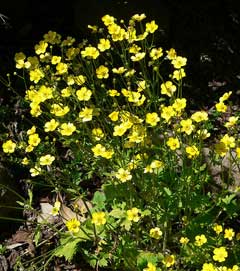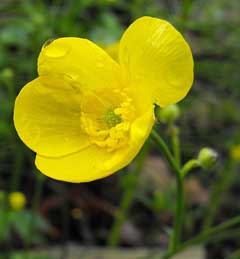 |
|
http://commons.wikimedia.org/wiki/User:Stan_Shebs |
 |
|
Translate this page:
Summary
Physical Characteristics

 Ranunculus japonicus is a PERENNIAL growing to 0.1 m (0ft 4in) by 0.3 m (1ft). It is in flower from May to July. The species is hermaphrodite (has both male and female organs) and is pollinated by Insects.
Ranunculus japonicus is a PERENNIAL growing to 0.1 m (0ft 4in) by 0.3 m (1ft). It is in flower from May to July. The species is hermaphrodite (has both male and female organs) and is pollinated by Insects.
Suitable for: light (sandy), medium (loamy) and heavy (clay) soils. Suitable pH: mildly acid, neutral and basic (mildly alkaline) soils. It can grow in semi-shade (light woodland) or no shade. It prefers moist soil.
UK Hardiness Map
US Hardiness Map
Synonyms
Plant Habitats
Cultivated Beds;
Edible Uses
Edible Parts: Leaves
Edible Uses:
Leaves - cooked[105]. The leaves contain a low level of toxicity that is not enough to be injurious[179].
References More on Edible Uses
Medicinal Uses
Plants For A Future can not take any responsibility for any adverse effects from the use of plants. Always seek advice from a professional before using a plant medicinally.
Antiperiodic Antitumor Decongestant Malaria Vermifuge
The plant is decongestant and vermicide[147, 218]. It is used in the treatment of malaria[147, 218]. The plant contains antitumour compounds[218].
References More on Medicinal Uses
The Bookshop: Edible Plant Books
Our Latest books on Perennial Plants For Food Forests and Permaculture Gardens in paperback or digital formats.

Edible Tropical Plants
Food Forest Plants for Hotter Conditions: 250+ Plants For Tropical Food Forests & Permaculture Gardens.
More

Edible Temperate Plants
Plants for Your Food Forest: 500 Plants for Temperate Food Forests & Permaculture Gardens.
More

More Books
PFAF have eight books available in paperback and digital formats. Browse the shop for more information.
Shop Now
Other Uses
References More on Other Uses
Cultivation details
We have very little information on this species and do not know if it will be hardy in Britain, though judging by its native range it should succeed outdoors in most parts of the country. It is clsely related to R. acris[266]. The following notes are based on the general needs of the genus. Prefers a moist loamy soil[1]. A greedy plant, inhibiting the growth of nearby plants, especially legumes[54].
References Carbon Farming Information and Carbon Sequestration Information
Temperature Converter
Type a value in the Celsius field to convert the value to Fahrenheit:
Fahrenheit:
The PFAF Bookshop
Plants For A Future have a number of books available in paperback and digital form. Book titles include Edible Plants, Edible Perennials, Edible Trees,Edible Shrubs, Woodland Gardening, and Temperate Food Forest Plants. Our new book is Food Forest Plants For Hotter Conditions (Tropical and Sub-Tropical).
Shop Now
Plant Propagation
Seed - sow spring in a cold frame. When they are large enough to handle, prick the seedlings out into individual pots and plant them out in the summer. Division in spring.
Other Names
If available other names are mentioned here
Native Range
TEMPERATE ASIA: China (Shaanxi Sheng)
Weed Potential
Right plant wrong place. We are currently updating this section.
Please note that a plant may be invasive in one area but may not in your area so it's worth checking.
Conservation Status
IUCN Red List of Threatened Plants Status :

| Related Plants
|
| Latin Name | Common Name | Habit | Height | Hardiness | Growth | Soil | Shade | Moisture | Edible | Medicinal | Other |
| Ranunculus acris | Meadow Buttercup, Tall buttercup, Showy buttercup | Perennial | 1.0 |
0-0
| | LMH | SN | MWe | 1 | 2 | 0 |
| Ranunculus aquatilis | Water Crowfoot, White water crowfoot | Annual/Perennial | 0.0 |
4-8
| | LMH | SN | MWeWa | 1 | 1 | |
| Ranunculus arvensis | Corn Buttercup | Annual | 0.5 |
0-0
| | LMH | SN | M | 0 | 1 | 0 |
| Ranunculus bulbosus | Bulbous Buttercup, St. Anthony's turnip | Perennial | 0.3 |
0-0
| F | LMH | SN | M | 1 | 2 | 0 |
| Ranunculus californicus | California Buttercup | Perennial | 0.6 |
6-9
| | LMH | SN | M | 1 | 0 | |
| Ranunculus chinensis | Hui Hui Suan | Perennial | 0.6 |
-
| | LMH | SN | MWe | 1 | 0 | |
| Ranunculus ficaria | Lesser Celandine - Pilewort, Fig buttercup | Perennial | 0.2 |
0-0
| F | LMH | SN | M | 1 | 2 | 3 |
| Ranunculus flammula | Lesser Spearwort, Greater creeping spearwort | Perennial | 0.6 |
4-8
| | LMH | SN | MWeWa | 0 | 1 | |
| Ranunculus hirtus | | Perennial | 0.0 |
-
| | LMH | SN | M | 0 | 1 | |
| Ranunculus inamoeus | Graceful Buttercup | Perennial | 0.3 |
-
| | LMH | SN | M | 1 | 0 | |
| Ranunculus kochii | | Perennial | 0.1 |
5-9
| | LMH | N | M | 1 | 0 | |
| Ranunculus muricatus | Rough-Seed Buttercup, Spinyfruit buttercup | Annual | 0.3 |
0-0
| | LMH | SN | M | 0 | 1 | |
| Ranunculus nipponicus | | Perennial | 0.0 |
-
| | LMH | SN | WeWa | 1 | 0 | |
| Ranunculus occidentalis | Western Buttercup | Perennial | 0.6 |
-
| | LMH | SN | M | 1 | 0 | |
| Ranunculus pallasii | Buttercup, Pallas' buttercup | Perennial | 0.1 |
0-0
| | LMH | SN | MWe | 1 | 0 | |
| Ranunculus pennsylvanicus | Pennsylvania Buttercup | Annual/Perennial | 1.0 |
-
| | LMH | SN | MWe | 1 | 1 | 2 |
| Ranunculus quelpaertensis | | Perennial | 0.6 |
-
| | LMH | SN | MWe | 1 | 0 | |
| Ranunculus repens | Creeping Buttercup, Prairie Double-flowered Buttercup, Water Buttercup, Creeping Buttercup | Perennial | 0.3 |
3-8
| F | LMH | SN | M | 1 | 1 | 0 |
| Ranunculus reptans | Creeping Spearwort | Perennial | 0.2 |
-
| F | LMH | SN | MWe | 1 | 0 | |
| Ranunculus rivularis | | Perennial | 0.0 |
-
| | LMH | SN | M | 0 | 1 | |
| Ranunculus sceleratus | Celery-Leaved Buttercup, Cursed buttercup | Perennial | 0.6 |
0-0
| | LMH | SN | MWeWa | 1 | 1 | 1 |
| Ranunculus tachreoi | | Perennial | 1.0 |
-
| | LMH | SN | M | 1 | 0 | |
| Ranunculus ternatus | | Perennial | 0.3 |
-
| | LMH | SN | M | 0 | 1 | |
|
Growth: S = slow M = medium F = fast. Soil: L = light (sandy) M = medium H = heavy (clay). pH: A = acid N = neutral B = basic (alkaline). Shade: F = full shade S = semi-shade N = no shade. Moisture: D = dry M = Moist We = wet Wa = water.
Now available:
Food Forest Plants for Mediterranean Conditions
350+ Perennial Plants For Mediterranean and Drier Food Forests and Permaculture Gardens.
[Paperback and eBook]
This is the third in Plants For A Future's series of plant guides for food forests tailored to
specific climate zones. Following volumes on temperate and tropical ecosystems, this book focuses
on species suited to Mediterranean conditions—regions with hot, dry summers and cool, wet winters,
often facing the added challenge of climate change.
Read More
Expert comment
Author
Thunb.
Botanical References
58266
Links / References
For a list of references used on this page please go here
Readers comment
| Add a comment |
|
If you have important information about this plant that may help other users please add a comment or link below. Only comments or links that are felt to be directly relevant to a plant will be included. If you think a comment/link or information contained on this page is inaccurate or misleading we would welcome your feedback at [email protected]. If you have questions about a plant please use the Forum on this website as we do not have the resources to answer questions ourselves.
* Please note: the comments by website users are not necessarily those held by PFAF and may give misleading or inaccurate information.
To leave a comment please Register or login here All comments need to be approved so will not appear immediately.
|
Subject : Ranunculus japonicus
|
|
|
|